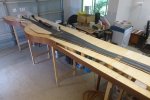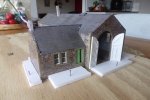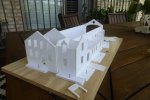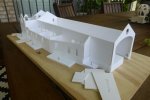Another WT resident has encouraged me to migrate my layout thread from RMWeb to here, although I am unconvinced that it will be of interest as it is not Western and has very little Thunder about it, but we'll see. I know little about railways, having not grown up in the UK, spent my childhood days watching trains go past, or worked in any rail industry. The objective was simply to have an interest and something to do in my semi-retirement. It's probable that the layout will never be finished, and indeed, will never make it to a show, and probably will be seen in real life by anyone who knows anything about model railways.
The layout portrays the terminus station at the town of Banff (Scotland, not the other one), where my wife's parents lived until they emigrated in 1958. Steam lingered there until it's final days in 1968. I'm happy to be modelling a real location, as it avoided extraneous procrastination in building a what-I-like layout while I figured out what it was that I actually liked.
After nearly 7 years of intermittent progress, procrastination and many Things That Must Be Done. I've got baseboards built and joined, track laid and powered, and points operating. I've completed construction of the engine shed, and am making a start on the station building. I've done no scenic-ing, so there's lots of bare plywood to be seen. Should anyone be interested in 20 pages of history, you will find it on RMWeb under the same thread name.
For those so interested, here's the "technologies" used
Trackplan:

Baseboards, track and mock-ups of the (l to r) goods shed, station building and engine shed (looking the opposite way to the trackplan):

The engine shed (still need to paint those doors, and a fair bit of fettling and detailing too):

The station building takes shape:


The layout portrays the terminus station at the town of Banff (Scotland, not the other one), where my wife's parents lived until they emigrated in 1958. Steam lingered there until it's final days in 1968. I'm happy to be modelling a real location, as it avoided extraneous procrastination in building a what-I-like layout while I figured out what it was that I actually liked.
After nearly 7 years of intermittent progress, procrastination and many Things That Must Be Done. I've got baseboards built and joined, track laid and powered, and points operating. I've completed construction of the engine shed, and am making a start on the station building. I've done no scenic-ing, so there's lots of bare plywood to be seen. Should anyone be interested in 20 pages of history, you will find it on RMWeb under the same thread name.
For those so interested, here's the "technologies" used
- OO-scale
- DCC
- trackplan designed in AnyRail from an OS map from the National Library of Scotland website
- 4 portable baseboards, each 1.2x0.6/0.8m (in storage between play sessions)
- C&L code 75 thin-sleeper track plus Peco unifrog or electrofrog points, laid on TrackLay and 5mm closed-cell foam, ballasted with Green Scenes ballast
- points operated through home-made decoders and 9G servos.
- buildings constructed with Ace Screen Board and ScaleScenes papers from CAD drawings done in SketchUp; windows & doors cut from plasticard using a Silhouette cutter
Trackplan:

Baseboards, track and mock-ups of the (l to r) goods shed, station building and engine shed (looking the opposite way to the trackplan):

The engine shed (still need to paint those doors, and a fair bit of fettling and detailing too):

The station building takes shape:




